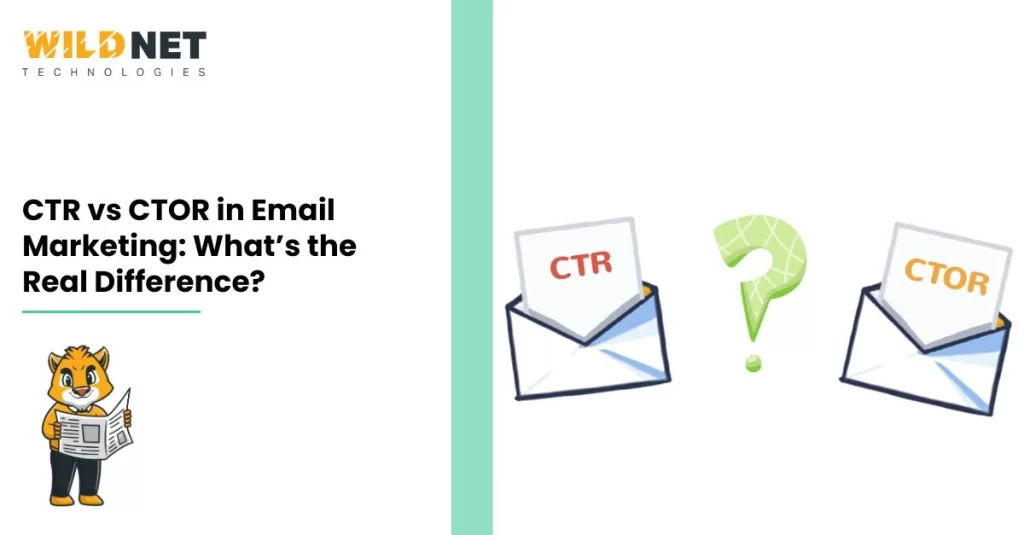In email marketing, brands often track multiple metrics to measure how well their campaigns are performing. Among the most discussed metrics are CTR (Click-Through Rate) and CTOR (Click-To-Open Rate). Although these two terms sound similar, they provide very different insights—yet marketers often confuse one for the other. That’s why search terms like CTR vs CTOR, CTOR vs CTR, and email CTR vs CTOR have become important for businesses hoping to understand the true effectiveness of their email campaigns.
If you want to measure whether your emails are actually engaging users, whether your content is convincing people to click, or whether your subject lines are performing well, understanding CTR and CTOR is essential. In this blog, you’ll get a clear explanation of the difference between CTR vs CTOR email marketing, how each metric influences strategy, and how combining both can help improve overall results.
What Is CTR? (Click-Through Rate)
CTR stands for Click-Through Rate, a universal digital marketing metric. When applied to email campaigns, CTR measures the percentage of recipients who clicked a link in your email.
The formula for CTR is:
CTR = (Total Clicks ÷ Total Emails Delivered) × 100
CTR helps marketers understand how successful the entire email is—from the subject line to the design to the messaging. It reflects:
- Email deliverability
- Subject line performance
- Audience targeting
- Content relevance
- Overall campaign appeal
If your CTR is low, it may mean that your message didn’t connect with your audience, the offer wasn’t compelling, or you sent the email at the wrong time.
What Is CTOR? (Click-To-Open Rate)
CTOR stands for Click-To-Open Rate, a metric that focuses on how recipients interact with your email after opening it. Unlike CTR, which is based on emails delivered, CTOR only considers people who opened the email.
The formula for CTOR is:
CTOR = (Unique Clicks ÷ Unique Opens) × 100
While CTR measures the performance of the entire email, CTOR measures the effectiveness of the email’s content. It tells you whether the copy, design, layout, and call to action were strong enough to encourage engagement.
If your CTOR is low, it usually means one of the following:
- Your email content wasn’t engaging
- The CTA wasn’t clear.
- The design didn’t guide users to click
- Your offer wasn’t compelling
- Your email was too long or confusing
CTR vs CTOR: The Key Difference
Although both metrics involve clicks, their purpose is completely different. That’s why understanding CTR vs CTOR is so important for email marketers.
Here’s the simple difference:
- CTR tells you how attractive the entire email was—before and after opening.
- CTOR tells you how effective the email content was—after it was opened.
Think of it like this:
- CTR = Interest + Engagement
- CTOR = Engagement Only
For example, you may have a high open rate because your subject line was strong, but if CTOR is low, it means the content inside didn’t convince people to click.
This distinction is crucial for improving email campaign performance. It helps identify exactly where problems exist—subject line, timing, messaging, design, or offer.
Why Email Marketers Must Measure Both CTR and CTOR
The search for CTR vs CTOR email marketing has increased because businesses realise that one metric alone cannot tell the whole story. If you only track CTR, you miss what’s happening after the email is opened. If you only track CTOR, you miss whether the email was appealing enough to be opened in the first place.
Let’s look at how both metrics work together:
1. High CTR + High CTOR
This is the best outcome. It means:
- Your subject line was effective
- Your content was relevant.
- Your CTA was engaging
- Your audience was well-targeted
2. High CTR + Low CTOR
This usually means:
- The subject line was strong
- People were curious enough to open.
- But the content disappointed them
3. Low CTR + High CTOR
This suggests:
- Your email content is strong
- But not many people opened the email.
- Subject lines or timing may be the issue.
4. Low CTR + Low CTOR
This indicates a poor overall campaign:
- Weak subject line
- Unengaging content
- Poor targeting
Monitoring both metrics helps you pinpoint the exact stage of the campaign that needs improvement.
How to Improve CTR and CTOR in Email Marketing
Once you understand email CTR vs CTOR, the next step is optimisation.
To improve CTR:
- Write stronger subject lines
- Segment your audience
- Use personalization
- Avoid spam-like wording
- Send emails at the right time.
To improve CTOR:
- Shorten your email copy
- Add visually appealing design elements.
- Use clear, bold CTAs
- Offer something valuable
- Make emails more mobile-friendly
When both metrics rise together, your email marketing becomes significantly more effective.
The Role of Strong Content Strategy
A great email strategy is more than just good design or catchy subject lines. It depends on understanding your audience, crafting meaningful messages, and aligning your content with user intent.
Many businesses track metrics like CTR vs CTOR email, but fail to improve because they don’t have a robust digital strategy. Content needs to be personalised, segmented, and aligned with user behaviour—and this requires expertise.
That’s where a professional partner can help.
Conclusion (For Wildnet Technologies)
As businesses continue to invest in email marketing, understanding the difference between CTR vs CTOR is essential for improving performance. Both metrics provide unique insights into how users interact with your emails—from the moment they receive them to the moment they click. When used together, CTR and CTOR help identify what’s working, what needs improvement, and how to deliver more engaging experiences to your subscribers.
At Wildnet Technologies, we help brands strengthen their email performance through strategic content planning, advanced segmentation, and AI-driven optimisation. Our team ensures that every stage of your campaign—from subject line to CTA—is designed to generate meaningful engagement. Businesses looking to enhance their overall online presence can also explore our comprehensive Digital Marketing Services, which support not just email marketing but your entire growth ecosystem.
With the right insights and expert support, your email campaigns can transform into powerful revenue-driving tools.
FAQs
1. What is the main difference between CTR and CTOR?
CTR measures clicks based on emails delivered, while CTOR measures clicks based on emails opened. CTR evaluates overall performance; CTOR evaluates content effectiveness.
2. Which is more important: CTR or CTOR?
Both are important. CTR helps you understand initial interest, while CTOR helps analyze engagement after the email is opened.
3. Why is my CTR high but CTOR low?
This usually means your subject line is strong, but your email content or CTA is not engaging enough to drive clicks.
4. Why is my CTOR high but CTR low?
Your content is effective, but few users opened your email. You may need better subject lines or improved audience segmentation.
5. How can I improve both CTR and CTOR?
Use personalised content, compelling subject lines, clear CTAs, segmented lists, and mobile-friendly designs to improve both metrics.
Read More
- Perplexity AI Brings Comet AI Browser & Email Assistant to India
- How Can Email Marketing Fuel Your Overall Inbound Strategy?
- What Is One of the Benefits of Using Templates for Your Email Marketing Campaigns?
- What Is Google Pomelli? A New AI Tool for Brand-Consistent Marketing
- Gen Z Don’t Use Google: How Social Search Took Over?






